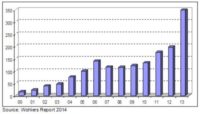INDUSTRY HEADLINE
Pressure Forming Popularity Grows 10 Percent In Plastics Manufacturing

ONTARIO, CA — Pressure forming saw a significant increase in popularity from last year, while other processes saw a dip in popularity, according to the 2015 annual plastics manufacturing industry survey results released by Ray Products
The survey, conducted annually over the past three years, asks professionals who use plastics manufacturing about their activities over the past 12 months, and about their plans for the next 12 months. This year’s survey was distributed to thousands of engineers, administrators and manufacturing professionals.
The respondents represented automotive, medical, and high tech manufacturers, as well as industrial designers and a range of other fields.
Comparing year-over-year data from the annual survey reveals trends in manufacturing. In both 2014 and 2015, respondents were asked to list the manufacturing processes they used in the past year. This year, pressure forming experienced the most growth in popularity, increasing over 10 percent from last year. Sheet metal and injection molding experienced the largest declines in popularity, down 17 percent and 12 percent, respectively.
“We’re seeing a big volume in people coming from other processes,” said Jason Middleton, vice president for sales and development for Ray Products. “Once people learn about the quality of pressure forming, the option to mold-in-color, the ability to create multi-part assemblies and the cost advantages at low to mid volumes, it becomes a very appealing process.”
The survey also revealed a 10 percent decline in domestic plastics manufacturing. In 2014, survey takers indicated that, on average, 64 percent of their plastics manufacturing happened domestically, while this year the average was just 54 percent.
Not surprisingly, the survey also showed a 4 percent year-over-year dip in respondents who said they were happy with their offshore plastics manufacturing, and had no plans to reshore.
“The idea of offshoring can be appealing,” said Middleton. “But when you look at the whole picture, including cost, shipping, quality and capability, domestic plastic manufacturing tends to make more sense.”
Additional survey results are available online at www.rayplastics.com/2015-thermoforming-survey-results/
Looking for a reprint of this article?
From high-res PDFs to custom plaques, order your copy today!









